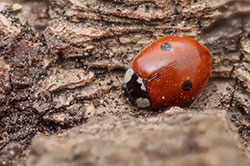
As summer turns to fall and temperatures drop, insects go through an abrupt change in life style. Their activity and development largely cease, but they have strategies to survive the winter. Insect overwintering is frequently used to refer to a sort of hibernation undertaken by insects to survive the cold temperatures. Insects can overwinter in any stage of their development unless they migrate. Most insects have a single generation life-cycle, but there are some that require two or more years to fully develop.
Some insects, such as whitefly and tomato psyllid, can’t survive unless they’re protected by a greenhouse or heated, indoor shelter. Those insects, and others such as Monarch butterflies, normally survive by migrating south and returning north for an upcoming growing season.
Other insects survive by adding an “antifreeze,” called glycerol, to their cells. In addition, most insects seek out protective sites and spend the winter below ground, under debris or in insulated areas. Winter diapauses, a state in which insects stop growing and developing, is broken only if a certain period of cold weather passes or insects become aware that days are getting longer.
Some other insects, such as lady beetles and box elder bugs, survive as adults in a process very similar to that of a bear hibernating in a cave. The overwintering pupae of most butterflies are attached to an above-ground object. Geranium budworm and other hornworm pupae survive in packed earthen cells three inches underground.
Mosquitoes, grasshoppers, aphids and scales spend the winter as eggs. Bark beetles, such as mountain pine beetle and wood borers, live on as partially grown larvae under the bark of infested trees.
An insect’s worst enemies are the alternating extremes of very cold and very warm weather that can come during late winter. This is the same type of weather that also endangers plant survival.
For more information, see the following Colorado State University Extension fact sheet(s).
- Boxelder Bugs
- Mountain Pine Beetle
- Shade Tree Borers
- Potato or Tomato Psyllids
- Tobacco (Geranium) Budworm



